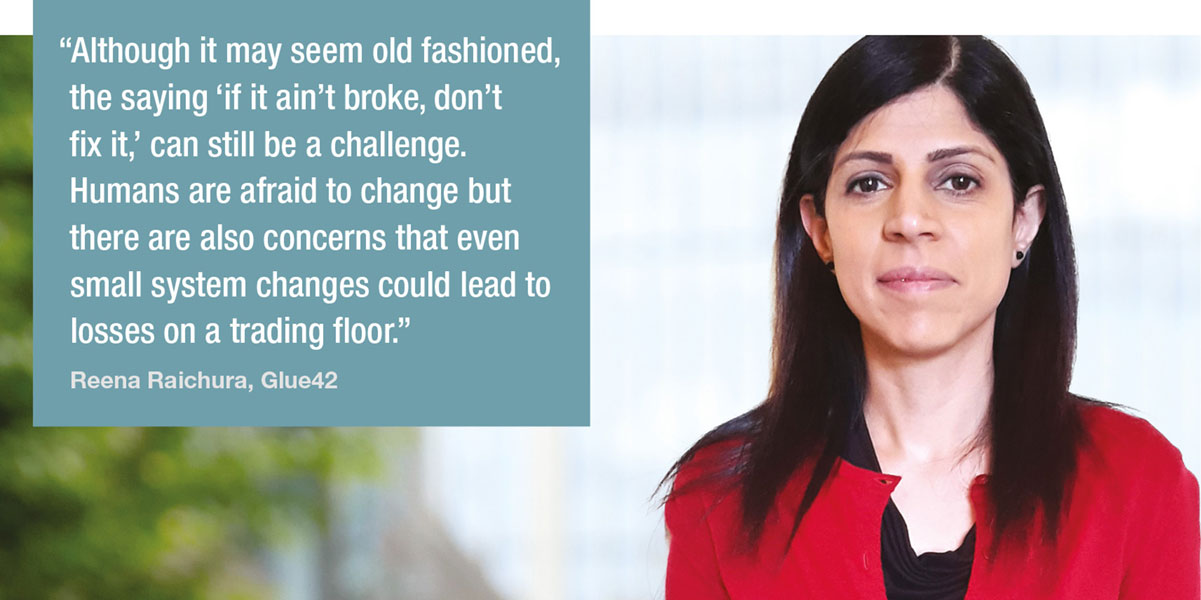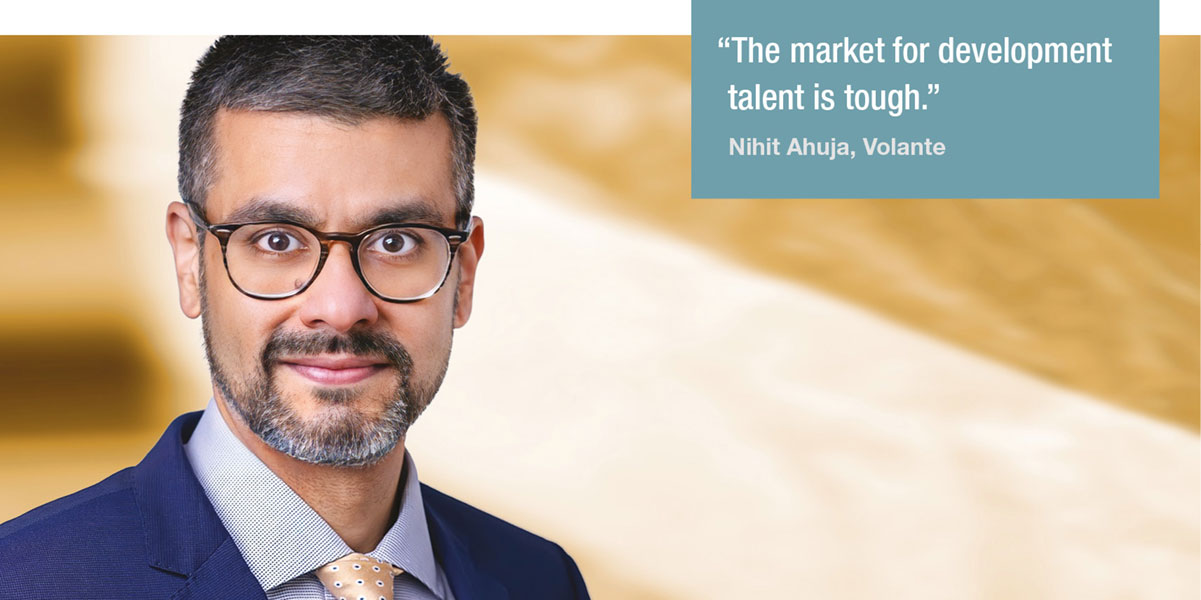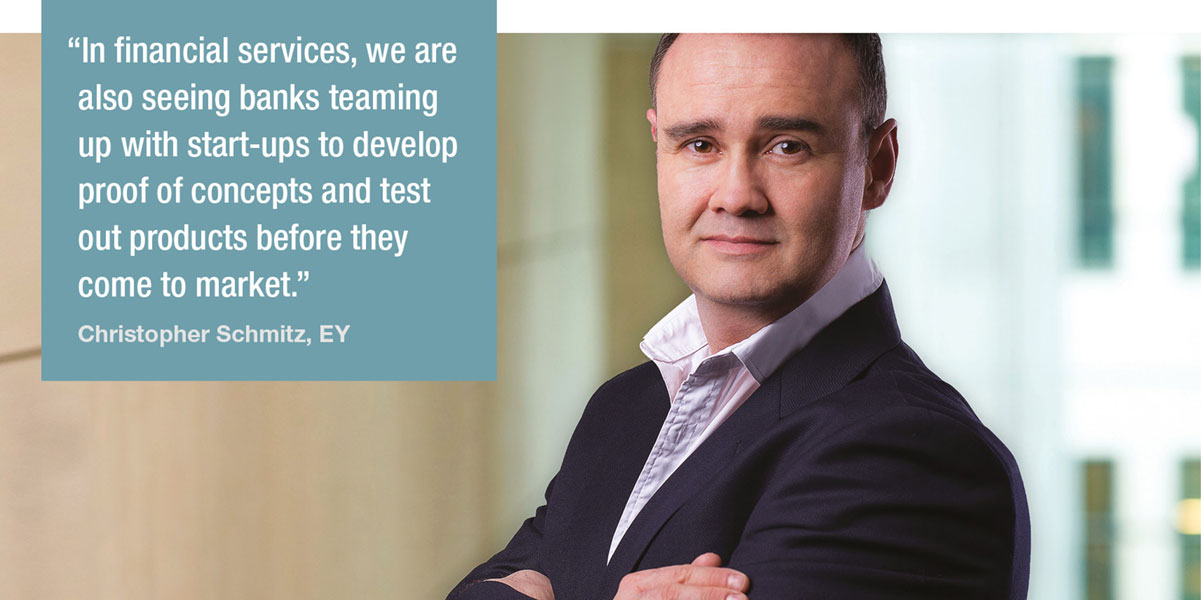
Lynn Strongin Dodds investigates the barriers to adopting new technology.
Technological advances may be developing at breakneck speed but many of the barriers of adoption are stuck in time. This is particularly true of a stodgy organisational culture and behavioural reluctance to innovation. Individuals may be more than happy to embrace new gadgets on a personal level, but resistance is seemingly their default position in the work environment.
The drivers are not just unique to buy and sell-side firms but are evident across the corporate spectrum. Top of the list is the fear of the unknown. As Reena Raichura, head of product solutions at Glue42, a financial desktop integration specialist, puts it, “Although it may seem old fashioned, the saying ‘if it ain’t broke, don’t fix it,’ can still be a challenge. Humans are afraid of change but there are also concerns that even small system changes could lead to losses on a trading floor.”
Raichura also notes that there needs to be much greater collaboration between the business and the technology teams to ensure that the new technology meets the needs of the company. Often there is a misunderstanding over the benefits, how to use the new technology and why it is being implemented.

“The focus should be more on the value add that the new technology can bring,” says Vijay Mayadas, president of capital markets at Broadridge Financial Solutions. “There needs to be a better understanding of what the technology can do. For example, if there is a complex trade and you are wondering what buy-side firm to ring, using artificial intelligence will help manage your list more efficiently.”
Skills shortages
Another pressing and increasingly significant hurdle is skills shortages. The dearth of talent has only been exacerbated by the pandemic which by some estimates has fast-forwarded digital adoption by five years in all sectors, according to a study by Gartner – Lack of Skills Threatens Digital Transformation.
Financial institutions, like many of their corporate counterparts, are well aware that they will fall behind if they do not attract and retain the best and brightest. Research from McKinsey revealed that 87% of executives are experiencing skill gaps in their financial services workforce while research by UK Finance found that 30% of the sector’s employees felt they needed more digital/tech expertise.
The skills most needed range from the technical such as data analysis and insights, software development, digital literacy to the more human side of creative thinking and coaching, according to the UK’s Financial Services Skills Commission (FSSC), report: Mind the gaps – skills for the future of financial services 2022.
The same applies to Europe with a report from IBM last year Addressing the AI Skills Gap in Europe, which shows particular concerns over the scarcity of technical capabilities as well as problem solving which it notes is considered the most critical soft skill needed for tech roles.

Unsurprisingly, competition is fierce with asset managers and investment banks vying with tech giants and fintechs for data scientists, engineers and software developers. “The market for development talent is tough,” says Nihit Ahuja, global business head from Volante, paytech and low-code platform provider. “Finding ways to either amplify what your current development force can do, shorten the time for a college graduate developer to become productive, or extend your development pool by recruiting talented business analysts, is a viable option to competing and winning in this challenging market. All of which help to ensure fewer rollout delays.”

Charlie Berman, CEO and co-founder of agora, a digital capital markets platform, though believes the situation is more complex than just finding the right talent. “It is not just about the lack of people but also the knowledge and understanding of what is changing and what is needed. Financial institutions still have many people who are still trying to grasp what the problems and opportunities are.”
Regulation is also seen as a stumbling block to adoption. On the one hand, it has generated a need for innovative tools but on the other it has introduced a much more stringent framework that can slow down progress. “The Amazon one-click experience does not exist in world markets,” says Berman. “They are still incredibly manual. Also, consumers do not think about AML/KYC operational risk when choosing technology. That is not the case when operating in the highly regulated financial service industry.”
Old and the new
As for the nuts and bolts, legacy systems continue to be a proverbial thorn in the infrastructure side. They have been built over the years either organically or via acquisition and have impacted growth as well as exposed financial institutions to additional risks and liability. In addition, the cadre of people who tend to these systems and are well versed in outdated computer languages are a dwindling number.

Although the ideal solution would be to have a complete overhaul, it is too costly and time consuming for many firms. “There is an acknowledgement that legacy systems are not going away, it’s too big or hard a task to rip out and replace widely embedded architectures” says Mark Croxon, global head of market infrastructure at Delta Capita. “What we are seeing is that firms are looking to reorganise what is core and central to them and what is not. They are focusing more on the bottom line to see where they need to optimise, potentially outsourcing non-competitively differentiating processes common to all industry participants, to third party run, widely used, network solutions.”

Partnerships are also increasingly becoming significant. “It is important for a company to not only have a clear vision but to also send out the right message about how it wants to transform itself,” says Christopher Schmitz, fintech leader EMEIA Financial Services at EY. “In financial services, we are also seeing banks teaming up with start-ups to develop proof of concepts and test out products before they come to market. This may take longer but the focus now is better meeting the needs of their clients.”
Andy Schmidt, vice president & global industry lead for banking at consultancy CGI also believes that one of the ways forward is partnerships. “Fintechs have the vision and innovation, while banks have the funding and the understanding of regulation and cybersecurity, and together they can partner to improve the customer experience, which is one of the key drivers for new technology investment today,” he says.
In the end though, market participants believe financial institutions have to change their mindset and build a stronger culture of technology adoption if they want to be successful.
This requires putting in place the right supportive infrastructure with IT networks, software, processes and practices throughout the business to be supportive and user friendly.
It also means having people across the organisation involved and not just the tech teams. Studies show that a lack of communication and distrust of management make employees wary of any change. To get the workforce onboard, there needs to be strong messaging from senior executives who are willing to listen, answer questions and explain to a reluctant audience how new technology will be beneficial to them as well as the organisation.
As Linda Coffman, executive vice president, responsible for overseeing The SmartStream Reference Data Utility, says “there is always congestion on the road map. It is the cost, time of the project and the human element. However, lack of communication is an issue, and the company needs people who can make the case to the budget holders in terms of the benefits that the new technology will provide to the business as a whole.”
©Markets Media Europe 2025










